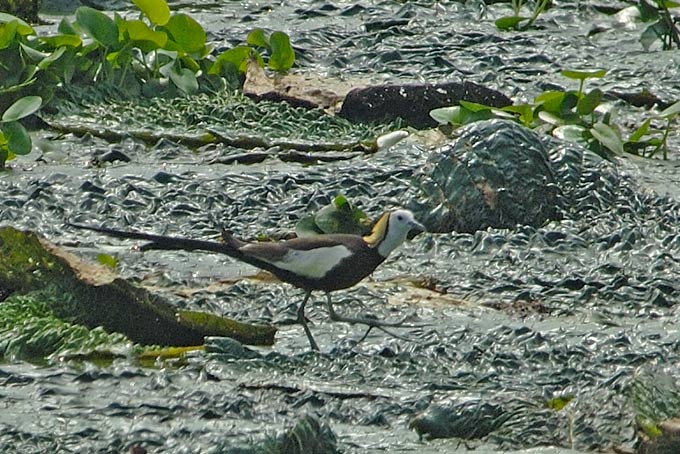 | E-mail to Birds Korea |
 | KWBS |
in the Region
 | The Oriental Bird Club |
 | BirdLife International (Asia) |
August
Typically hot and humid (with day maxima often around 30°C until at least mid-month), with occasional heavy rains and strong winds, associated either with southern typhoons or caused by the mix of humidity and heat.
Chinese Egrets become widespread along the west coast. Shorebirds (including a very small number of Spoon-billed Sandpiper) begin to build up at many of the remaining best sites. Numbers tend to be rather lower than in spring, though Kentish Plover and Terek Sandpiper often number in the thousands in the southwest.
Parties of Black-naped Orioles, the appearance of returning leaf warblers (especially Eastern-crowned and Arctic Warblers) and small numbers of Brown Shrike and Yellow-rumped and Brown Flycatchers by mid-month also hint at the start of passerine migration, while Eurasian Hobby and Chinese Sparrowhawks appear to be on the move by the month's end. At the very end of August, the first migrant Pechora Pipit (probably of the subspecies menzbieri) and migrant buntings also appear on offshore islands especially.
Seabirds have provided most interest in recent Augusts, with three records of Sooty Tern, Korea's first Sooty Shearwaters (in 2002), and a Lesser Frigatebird overflying Socheong and Korea's first Aleutian Tern seen from the Socheong ferry in 2004, with another in 2006.
(The following records are a compilation of our own sightings and records sent in by other observers. As well as being posted on the Birds Korea website(s), selected records are also forwarded to other Korean-language birding websites; records of threatened species are arranged and forwarded to Birdlife International and national authorities when appropriate; flag images and records are passed to bodies responsible for their coordination throughout the flyway; and all records sent to us are used to compile annual reports and to support the evolving understanding of the status of many of Korea’s birds.)
Yeongjeong Island, August 31
The southern lock reservoir has undergone serious destruction at the hands of developers, with most waterside vegetation replaced by concrete and bulldozers tearing out what little remains. 2 years ago this area held many Little Terns, assorted shorebirds and several Chinese Egret. Today however, only 3 Coot (a mother with 2 juveniles), and a flock of Common Greenshank.
On the mudflat at Yongyudo, at least 12 Chinese Egret, (including some juveniles) were comically dashing and stabbing fish in the shallows. Nearby, single numbers each of Sharp-tailed Sandpiper, Terek Sandpiper, Common Sandpiper, Grey-tailed Tattler (2), Eastern Oystercatcher (1), Eurasian & Far Eastern Curlews, Whimbrel, Grey plovers and Red-necked Stints.
Best at the salt pans nearby was a mother and juvenile Yellow-rumped flycatcher and a Common Kingfisher.
Uiwang, August 29
In very wet weather, a brief circuit of the reservoir flushed a presumed Pintail Snipe along the edges of a ricefield (low, direct flight, no jinking, and other features). Oriental reed warblers still plentiful in the reeds, and a Grey Wagtail, 2 Common and 1 Green Sandpiper along the stream. Dashing across the path and quickly into dense streamside undergrowth, a Ruddy Crake.
Songdo (Incheon), August 23
The remaining flats at Songdo in very hot (and hazy) conditions; due to less-than-ideal tide, most birds were quite distant. Within sight but too far to count with accuracy were (presumed all or mostly Black-tailed) Godwits, maybe 2 thousand; and several thousand Great Knot, identified more by flock-texture more than by any visible individuals! Maybe 1000 Common Greenshank noted, several hundred Red-necked Stint, 400 Terek Sandpiper, several hundred Grey Plover, about 50 Golden Plover, 20 Ruddy Turnstone, and 3 Common Redshanks. Only 12 Mongolian Plover noted. Also 32 Black-faced Spoonbills and a single Common Tern. On a nearby Freshwater area, a family of Moorhens, several Wood Sandpipers, 12 Marsh Sandpipers, 2 Green Sandpipers, 5 Common Sandpipers, 3 Long-toed Stints, 100 more Red-necked Stints, a few Sharp-tailed Sandpipers, and an additional 600 Black-tailed Godwits.
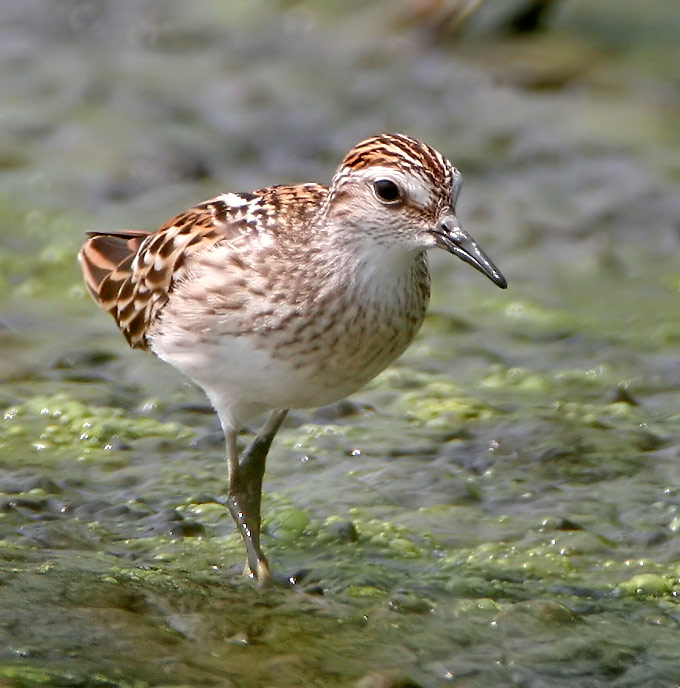
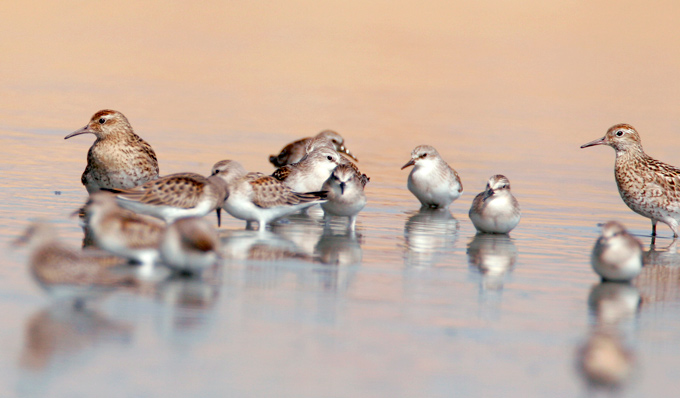
Songdo is clearly one of the last best areas of habitat (a potential mecca for eco-tourism, both domestically and internationally!) remaining in the Seoul/Incheon area, of obvious importance to the birds noted here as well as for Saunder's and Relict Gulls, and every effort should be made to push for the preservation of the small bit that is left.
National media have reported a large die-off of birds, most especially Black-tailed Gull Larus crassirostris, in the Geum Estuary. On Friday, August 17th, Nial Moores and Dr. Dennis Buss found 14 dead Black-tailed Gull and a sick Great Egret Egretta alba sitting on the mud-flat, with its legs sticking up in the air. By August 19th, over 500 Black-tailed Gull were reported dead, along with several Little Egret Egretta garzetta and two Ruddy Turnstone Arenaria interpres. Several of the dead birds have been collected and tested by veterinary experts. While the cause of death has yet to be firmly established, it appears at this time that avian botulism is responsible. All birdwatchers who find concentrations of sick or dying birds in Korea are asked to please contact Birds Korea, and to contact immediately Dr. Kim Young Jun of the Wildlife Rescue Center, College of Veterinary Medicine, Kangwon National University (at: ecovet (at) yahoo.co.kr) for advice.
Australia’s leading magazine, The Bulletin, has just published a three page article on the threats of the Saemangeum reclamation to Australia’s birdlife, based on images provided by Dr. Charles Page, and interviews with Birds Korea and our partners the AWSG. A shortened version of the story with images can now be found at: http://bulletin.ninemsn.com.au/article.aspx?id=287998.
Socheong-do, August 20 - 21
A short trip to Socheong in oppressively hot weather. Ferry trip out (only partial outside access) plowed through extremely calm seas and 2 relatively bird-rich spots: at one, about 50 Common Tern, 200 Streaked Shearwaters and 8 Swinhoe's Storm-petrel. In another area, about 100 more Common Tern and one strikingly dark, possible Aleutian Tern (it appeared to have the distinctive head pattern, but views were not ideal. Flight views inconclusive).
On the island, no sign of the Frigatebird discovered by N.M. and D.B. two days earlier, and the following highlights probably repeat what they saw before my arrival.
Blue Rock Thrush and Siberian Stonechat seem to own the island. Several Chinese Bulbul seen or heard; significantly, two were relatively young looking juveniles. Other young birds noted were Yellow-rumped Flycatcher, Brown Shrike, and Meadow Bunting. A flock of 12 Pacific Swift held one House Swift. A few Sand Martins shadowed the swifts. At North Point, a single probable Blyth's Pipit (poorly seen but slightly better heard) and 1 Eastern Crowned Warbler. Only one (unidentified) Cuckoo seen, in brief flight. At the beach, 2 Wood Sandpiper and 1 Ruddy Turnstone.
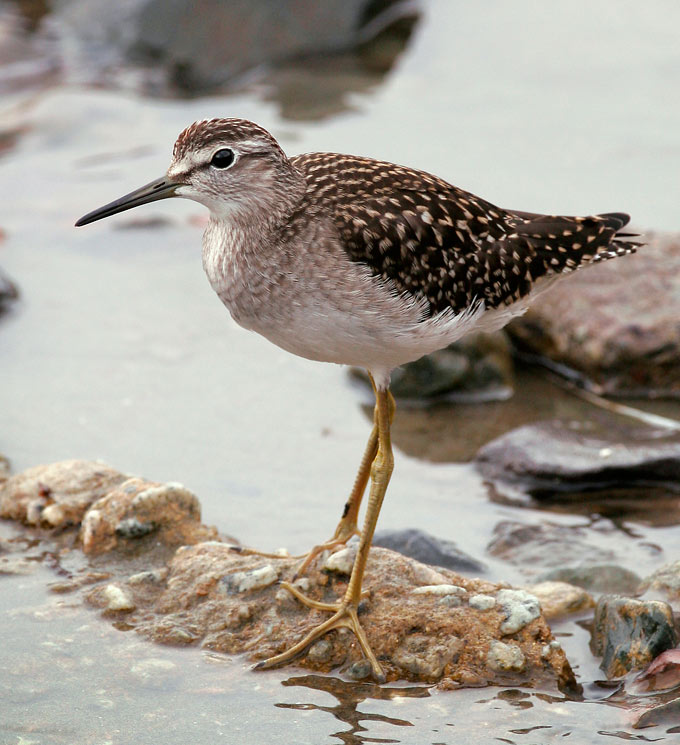
The return ferry (outside access) was relatively quiet, with smaller numbers of Shearwater, and only 6 Storm-petrel noted. Only 1 Common Tern seen on the water, with about 30 seen in flight.
Mokpo tidal-flat, August 21
The very small Mokpo tidal flat along the Gatbawi Road is now visited by many species again. Today's counting had listed Little Egret 28, Great Egret 24, Grey Heron 9, Striated Heron 1, Common Redshank 1, Common Greenshank 34, Black-tailed Gull 26, Ruddy Turnstone 32, Terek Sandpiper 19, Grey Plover 1, Whimbrel 29, Grey-tailed Tattler 30, Black-tailed Godwit 23, Little-ringed Plover 13, Common Sandpiper 2, Red-necked Stint 8, Far Eastern Curlew 1 and Common Moorhen 2. Around the location also Eurasian Tree Sparrow 9, Barn Swallow 22, Eurasian Magpie 3, Oriental Turtle Dove 2 were seen.
Song Do tidal-flat and Cheorwon, August 21
At Song Do, some mud still remaining during this, the weakest (neap) high-tide of the month. In total, an estimated 17,000 shorebirds of 22 species in total logged, with most numerous Black-tailed Godwit (ca 6,200), Great Knot (3,500), Common Greenshank (3,000), Grey Plover (1,500) and Mongolian Plover (1,000).
Species of special conservation concern included 58 Black-faced Spoonbill (almost 4% of the world population), 4 Saunders's Gull (including one young juvenile) and 2 Nordmann's Greenshank, one a (mostly sleeping!) non-breeding plumage adult, and the other, either a worn breeding-plumaged adult or perhaps less likely a juvenile, watched briefly as it fed frantically across almost the whole length of the tidal-flat, alternating running, pecking and twisting flights.
At a reservoir in Cheorwon, at least 2 von Shrenck's Bittern, probably 10 or more sightings of Yellow Bittern, 5+ Chinese Pond Heron (including what appeared to be a fairly young juvenile), 10+ Mandarin Duck and 4 Long-toed Stint.

Socheong Island-Ferry to Incheon-Song Do, August 20
Continuing very hot (again 30 C or 31 C on Socheong, and 32-33 C in Incheon) after an early morning period of rain.
Rather more evidence of early autumn movement on Socheong, with species of note including a male Grey Nightjar, probably 3 Daurian Starling, 8+ Eastern Yellow Wagtail, single Forest Wagtail and Blyth's Pipit (considered a different individual to that on 19th), calling Yellow-browed Buntings and Tristram's Buntings, 3 Pallas's Grasshopper, 1 Middendorff's and one Lanceolated Warbler, 1 Thick-billed and 10 Brown Shrikes, and 2-3 Light-vented Bulbul (heard only).
From the ferry, with fairly good viewing conditions, 103 Swinhoe's Storm-petrel (including one feeding group of 37), 301 Streaked Shearwater and 146 Common Tern. Most intriguing and significant was a single murrelet which (while rather distant) appeared to be an obvious non-breeding plumaged (or perhaps juvenile?) Long-billed. With bright sunshine from behind the observer, the bird showed a cleanly contrasting pied Long-billed Murrelet type plumage, including white scapulars. A paper by Steve Mlodinow (found at: http://www.birdchat.net/birdingmlodinow.pdf) suggests that both juvenile and even some adult Long-billed Murrelet might show non-breeding plumage as early as August (somewhat contra Sibley's North American Bird Guide).
At Song Do, reclamation now ongoing of a strip of the highest part of the tidal-flat, the last major and still internationally important tidal-flat area in Incheon City. On the lagoon there, an internationally important count of 7,950 Black-tailed Godwit, while on the main tidal-flat at least 3,000 Common Greenshank and 108 Eastern Oystercatcher.

Mokpo, August 20

The little tidal river bank is visited every day by Grey Herons and Egrets. This day 3 Grey Herons and 9 Little Egrets came for feeding. But this morning a very uncommon sound demanded special attention. A look from the apartment with a telescope and a little walk down confirmed the first time visit of two Common Greenshank and the second time visit of a Grey-tailed Tattler in the last three and a half years.
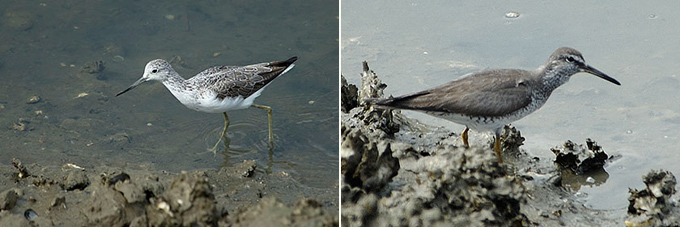
Socheong Island, August 19
With dense fog and rain showers through the early morning and hot (30C), very humid conditions in the afternoon, a small arrival with birds still hard to find. Species of most note included a Blyth's Pipit (watched well and heard to call), single Siberian Blue Robin, Thick-billed Warbler and Thick-billed Shrike, ca 16 Yellow-rumped Flycatcher, one Middendorff's, and 6+ Pallas's Grasshopper Warbler.
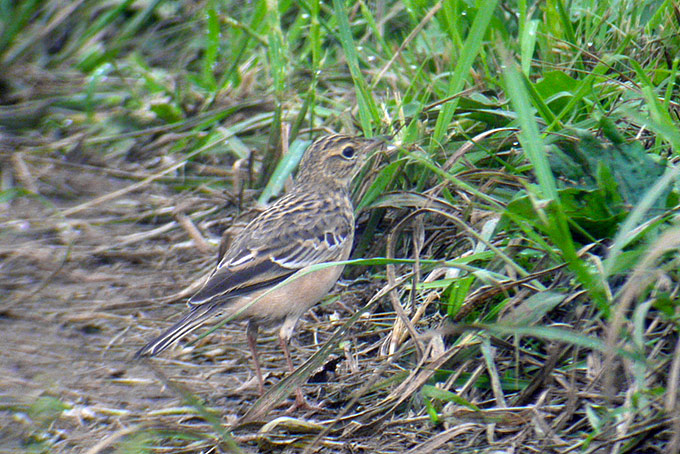
Geum Area-Incheon Ferry to Socheong, August 18
Near the Geum Barrage Lake, a calling Japanese Bush Warbler was a very unusual find (this taxon is very much restricted to the southern coastal zone and offshore islands, including Eocheong: it is not found inland so far north). From the afternoon ferry to Socheong, 13 Swinhoe's Storm-petrel, 149 Streaked Shearwater, 2 Ancient Murrelet and 192 Common Tern. On Socheong itself, only two hours of birding in very dull and overcast conditions produced several interesting birds, including two House Swift and outstanding highlight, a juvenile/immature Lesser Frigatebird, sitting on concrete blocks in the main harbor, before flying around with Black-tailed Gulls, when its white axillary spurs and limited white on underparts were well-noted. This, surprisingly, is the second record of this species on Socheong, with a juvenile well-photographed in flight there on August 9th 2004 (see: Lesser Frigatebird (August 2004)).
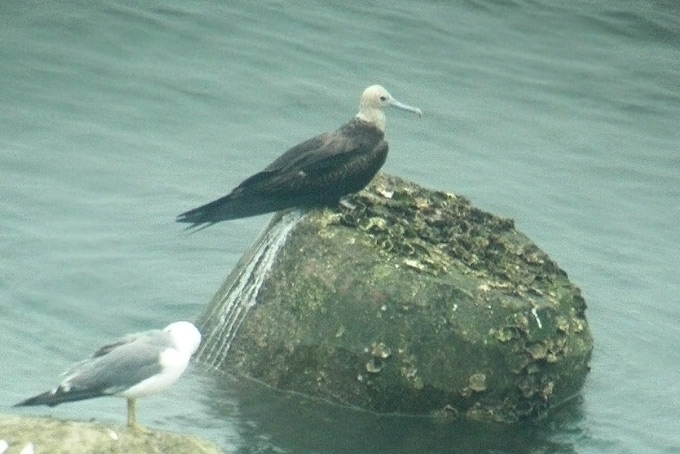
Yubu Island-Hwaum Sa-Geum Estuary (mainland), August 17
A very good day, again in very hot temperatures (reaching 34 C locally). On Yubu, at least 3 adult Spoon-billed Sandpiper, found within20 minutes of first light, and 35 Greater Sand Plover - a very high number for Korea. At Hwaum Sa, 16 Hill Pigeon - watched very well. At the Geum, close to 16,000 shorebirds, with most numerous Great Knot (9900), Bar-tailed Godwit (2430), Terek Sandpiper (1850) and at least 530 Grey-tailed Tattler - an internationally important count. Of further note, at Shellfish harbour 4 Saunders's Gull (including a young juvenile) and 48 Chinese Egret.
Yubu Island, Geum Estuary, August 16
With high tide at 5 am and 5:30 pm, a whole day spent on Yubu in sweltering temperatures of ca 33C. In total, ca 13,000 shorebirds, with most numerous Great Knot (3700), Mongolian Plover (3320), Eastern Oystercatcher (2240), Eurasian Curlew (1700) and Sanderling (590). Outstanding highlights included 2 or 3 breeding-plumaged Spoon-billed Sandpiper, a juvenile Styan's Grasshopper Warbler food begging from an adult, and rarest of all from a Korean perspective, an adult Oriental Plover (moving from breeding into non-breeding plumage, seen by NM only for ca 3 minutes at medium-range). This latter species is recorded barely annually in Korea (mostly on Jeju in spring). In addition, one adult and one young juvenile Saunders's Gull (suggesting local breeeding?), and 5 Chinese Egret.
Undisclosed Location, August 11
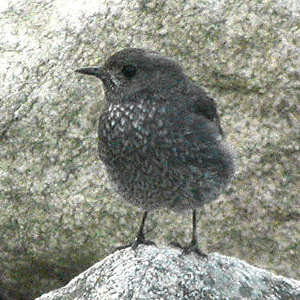
A brief visit in the late evening to an undisclosed location found only one female Plumbeous Water Redstart in very worn plumage. The same area was occupied by a pair in the early summer, with urgent and repeated food-carrying to a nest-hole observed in April; and with the male and female (but no young) observed at the same location in May. Lack of time prevented a search of adjacent areas in either June or July or on this date, and it is unclear whether the young were fledged successfully or not. While the nest site itself seemed very secure and inaccessible, the male and female often fed on a road. In 30 minutes of observation in May, the female narrowly avoided being hit by cars on several occasions, and it is easy to imagine that any young feeding in the same way in the same place would have been at a very high risk of being killed by cars.
In the river there, also juvenile Japanese Wagtail (3) and a juvenile Common Sandpiper - the latter either an early migrant, or perhaps the offspring of a pair that were also here in April and May.
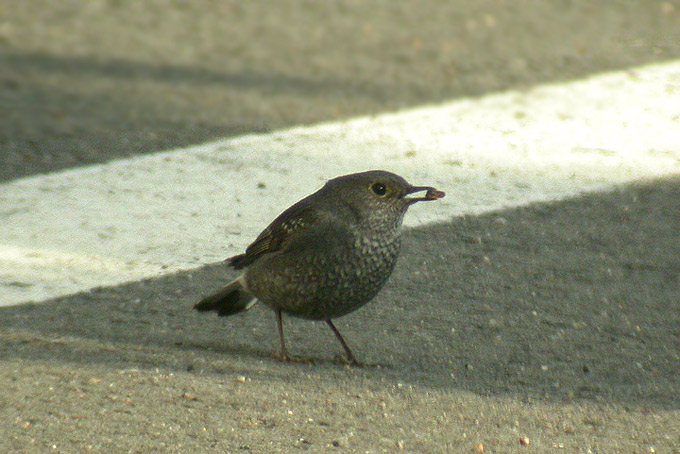
Geum Barrage, August 7
On a falling 5.28 m tide, a total of 847 birds from 16 species. Most numerous were 478 voraciously feeding Black-tailed Godwit. 104 Common Greenshank were also on the prowl, along with 98 Terek Sandpiper.
Like Simpo last week, Mongolian Plover (60) were quite numerous, and, though there were no Great Knot present here, more Eurasian Curlew (29) were counted. Grey Plover, Bar-tailed Godwit and Dunlin ranged from 15-30, while small numbers of Common Redshank (4), Common Sandpiper (3), Far Eastern Curlew (3), Red-necked Stint (11), Whimbrel (3), Eastern Oystercatcher (4), Kentish Plover (1) and a single Grey-tailed Tattler were also following the tide down the mud flat.
Evidently, the Fall migration has begun!
Northern Mongolia, August 6
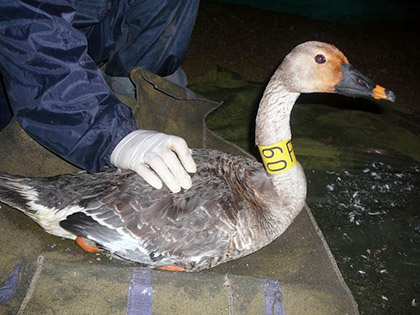
30 Whooper Swan, 50 Bar-headed Geese and 21 Bean Geese have this month been fitted with unique collars as part of an Avian-Influenza related waterbird monitoring program. A number of shorebirds will also be fitted with coloured leg-flags (blue over green on the right leg) as part of the same initiative.All observers are respectfully asked to send in any sightings of these birds to Dr. Martin Gilbert (mgilbert@wcs.org), copied to Birds Korea (mailto:inquiries@birdskorea.org).
For more details, please go to: Birds Korea Poultry Flu main page).
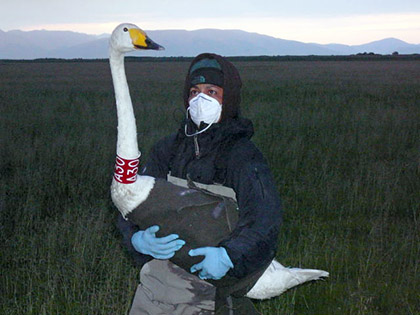
Simpo, August 3
A morning trip to Simpo produced some rather interesting results. We were surprised by the low height of the water, suggesting the maximum height of inflowing water has decreased since the end of the SSMP. There was still some tidal movement, however, we noticed it trickling over 3 hours past the huge morning high tide, indicating that the sluice gates are still hardly open at all.
Bird numbers also surprised us, as we counted 17 species with a total of 3,184 birds. Great Knot were most numerous at 868, with the birds being strangely split into two camps - one, extremely well-fed with a breeding plumage score of 4 or 5 (out of a full-breeding plumage 5), and the other rakishly thin with varying degrees of breeding plumage, from a single 0 up to 2.
Other species included Dunlin (536), Mongolian Plover (491), Bar-tailed Godwit (394), Kentish Plover (191), Terek Sandpiper (88), Common Greenshank (77) and Grey Plover (56).
Appearing in numbers less than 50 were Ruddy Turnstone, Broad-billed Sandpiper, Red-necked Stint, Eastern Oystercatcher, Whimbrel, Far Eastern and Eurasian Curlews, Grey-tailed Tattler, and 9 salmon-coloured Red Knot.
Yanggu, July 29
I had some interesting bird observations this weekend around Yanggu. Saturday, during my bird survey in the CRZ area near the Peace Dam I saw a pair of Grey-headed Woodpecker. I haven't seen them there before. I also saw and heard the same species closer to Yanggu last week in Ungjin-ri between classes at summer English camp. I'm sure this species has some sort of annual migration as it only appears at certain times of the year and then they seem to be numerous.
The other interesting bird I saw during my CRZ survey was a white headed North Korean form Long-tailed Tit Aegithalos caudatus caudatus with a flock of the more typical South Korean form A. c. magnus (about 14 birds). They were moving throughfoliagein feeding guild with 2 Eurasian Nuthatch and 2 Eastern Crowned Warbler. Unfortunately I didn't get a photo.
Today in Yanggu, I saw more Common Sandpiper than I usually do and a Red-necked Stint. Siberian Stonechat were notably absent today. Oriental Reed Warbler were not giving full voice today, only making tentative weezes. I wonder if this is early southward migration or could it be that the thunder storm that arrive just before 11:00 had something to do with it.
Joonam Reservoir, July 28 and 29
In extreme heat (reaching 35C) the oustanding highlight was an adult male Pheasant-tailed Jacana - apparently present here since mid-month.
